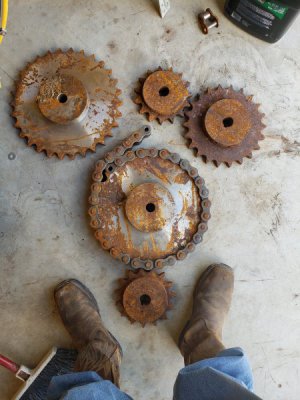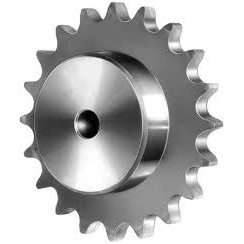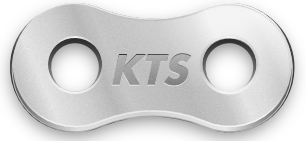- Joined
- Oct 29, 2012
- Messages
- 1,329
Scrap bin find: got several large 24B sprockets and a small scrap of chain. I don't have enough chain to do anything useful with this, and the chain is very expensive. I'm not planning on buying more. So the thought occurred to me to wrap the chain around one sprocket and have another sprocket mesh with it, like a gear. But the problem is that the teeth of the two sprockets hit each other.

In the above picture you see what I mean. The large sprocket with the chain around it would have the 5 free links cut off and then be attached to itself for a continuous loop around the large sprocket and the smaller sprocket at the bottom would mesh with it. Except the tips of the sprocket teeth touch before meshing can occur.
But what if I cut the tips off of all the teeth off of the large sprocket and then welded it in place, so that the smaller sprocket could mesh?
Would this work?
If so, what are the implications? In my mind, there are positives and negatives; please peer review my ideas:
(I think it will work with some caveats)
1. Positive. The horsepower capacity charts in chain drive datasheets drops off dramatically as RPM increases above a certain threshold. This is (I think) due to the chain's ability to flex at high speed without flapping. Since it won't be flexing, it should be capable of much higher speed. Closer to a gear set's speed/power curve at high speed.
2. Negative. The limiting factor of applied torque in typical chain drive applications is based on tensile strength of the chain (I think) which is much lower than the sum of the strength of the number (typically high number) of individual teeth engaged, so tooth strength is disregarded and the teeth are probably not hardened for added strength like gear teeth are. Since now only 1 or 2 teeth will be engaged at a time, the focus shifts to shear strength of the chain pins and the sprocket teeth, to which probably very little attention was ever paid in the factory. This is a bit of a wild card. I won't know how much torque I can put on it until I find it empirically, at which point I don't have any replacement parts. But I can't see the pins or teeth shearing without astronomical torque applied.

In the above picture you see what I mean. The large sprocket with the chain around it would have the 5 free links cut off and then be attached to itself for a continuous loop around the large sprocket and the smaller sprocket at the bottom would mesh with it. Except the tips of the sprocket teeth touch before meshing can occur.
But what if I cut the tips off of all the teeth off of the large sprocket and then welded it in place, so that the smaller sprocket could mesh?
Would this work?
If so, what are the implications? In my mind, there are positives and negatives; please peer review my ideas:
(I think it will work with some caveats)
1. Positive. The horsepower capacity charts in chain drive datasheets drops off dramatically as RPM increases above a certain threshold. This is (I think) due to the chain's ability to flex at high speed without flapping. Since it won't be flexing, it should be capable of much higher speed. Closer to a gear set's speed/power curve at high speed.
2. Negative. The limiting factor of applied torque in typical chain drive applications is based on tensile strength of the chain (I think) which is much lower than the sum of the strength of the number (typically high number) of individual teeth engaged, so tooth strength is disregarded and the teeth are probably not hardened for added strength like gear teeth are. Since now only 1 or 2 teeth will be engaged at a time, the focus shifts to shear strength of the chain pins and the sprocket teeth, to which probably very little attention was ever paid in the factory. This is a bit of a wild card. I won't know how much torque I can put on it until I find it empirically, at which point I don't have any replacement parts. But I can't see the pins or teeth shearing without astronomical torque applied.



